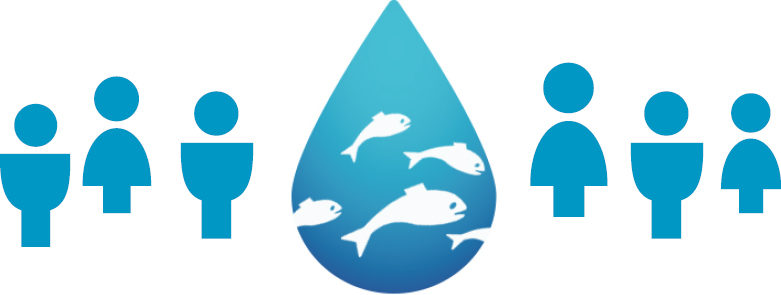Sufficient aquatic food
The key element SUFFICIENT refers to the amount of food from oceans and inland waters available for human consumption and relies on: amount of food we can harvest, produce and preserve; reduction of food loss and waste; and access to affordable aquatic food. Relevant SDGs related to this element are SDG 2, 3, 4, 6, 9, 12, 14, 16, 17. Relevant recommendations from the Committee on World Food Security are CFS 3, 4A.4, 4A.5, 4B, 4C, 4D. More links are required, especially for topics where no links are present yet. Please send input to FoodFromtheOcean@hi.no
Key element SUFFICIENT AQUATIC FOOD
SDG 2, 4, 9, 12 and 14
CFS 4A.4 and 4C
Knowledge
Sustainable utilization of marine living resources
- EAF Nansen programme Ecosystem Approach to Fisheries (FAO)
- ICES The International Council for the Exploration of the Sea
Multi- and bilateral projects
- EAF Nansen programme Ecosystem Approach to Fisheries (FAO)
Monitoring for scientific advice
Illegal, Unreported and Unregulated (IUU) fisheries
- Blue Resilience Project (UNDP)
Reports
- Assessment of commitments on sustainable fisheries to the Our Ocean conferences
- Fisheries in the drylands of sub-Saharan Africa -Fish come with the rain (FAO)
- CFS HLPE #7 ‘Sustainable fisheries and aquaculture for food security and nutrition’
- The State of World Fisheries and Aquaculture biennial reports (FAO)
- CFS HLPE #17 ‘Data collection and analysis tools for food security and nutrition’
Solutions
Monitoring national fisheries
- Fisheries monitoring Centre (NO)
- Stock assessment for data limited fisheries (LINK REQUIRED)
- Act relating to the management of wild living marine resources (NO)
Examine the potential to use mesopelagic resources (LINK REQUIRED)
Implementation of guidelines
- Securing sustainable small-scale fisheries: Showcasing applied practices in value chains, post-harvest operations and trade
Illegal, Unreported and Unregulated (IUU) fisheries
Resource
- Convention on Biological Diversity (CBD) target 6 (quick guide) (ICSF)
- Sea Around Us the FishPath tool
Guidelines
- Voluntary Guidelines on the Progressive Realization of the Right to Adequate Food (No. 2 and 8E) (FAO)
SDG 2,4, 12, 14, 16 and 17
CFS 3, 4B and 4D
Knowledge
Sustainable feed ingredients
Reports
- Demand and supply of feed ingredients for farmed fish and crustacean
- CFS HLPE #7 ‘Sustainable fisheries and aquaculture for food security and nutrition’
- The State of World Fisheries and Aquaculture biennial reports (FAO)
- The Ocean as a Solution to Climate Change: Updated Opportunities for Action (Ocean Panel)
Solutions
Sustainable feed ingredients
- AquaVitae Atlantic consortium looking for sustainable solutions for aquaculture
- Insects for Peace
Guidelines
- Voluntary Guidelines on the Progressive Realization of the Right to Adequate Food (No. 2, 3, 8 (E and F)) (FAO)
Implementation of guidelines
- Guidelines for Sustainable Aquaculture (GSA). Regional consultations started in 2019. There is a report on the Regional Consultation on Africa (FAO)
Non-fed aquaculture for food and feed
- Seaweed production: ‘Ocean Forest’; ‘Red Seaweed Promise’; ‘Safe seaweed by design protocols’
Transparency and traceability (collate, compile and summarise existing information)
Knowledge
Reports
- CFS HLPE #8 ‘Food losses and waste in the context of sustainable food systems’
- Right to food Discussion paper ‘Food loss and waste and the right to adequate food: making the connection’
Resources
- Solutions
Reduce food loss and waste in the value chain (SDG 6.4, 12.3, 12.5 and CFS 4A.5)
- Food loss and waste in fish value chain, FAO web tool
- Food Heroes North-West Europe initiative to reduce food losses in fish, meat and fruit & vegetable sector
- Stop food waste program (Ireland)
- Improved post-harvest technologies (e.g. such as smoking ovens, and drying racks) LINK?
- Solutions for Reducing Food Loss and Waste (FLW) (FAO)
SMART Commitments
- Norway has made a SMART commitment in line with SDG 12.3; by 2030 halve per capita global food waste at the retail and consumer levels and reduce food losses along production and supply chains, including post-harvest loses
SDG 2, 12, 14, 16 and 17
CFS 4B and 4D
Solutions
National industry standards
Knowledge
Research projects
- WGIBAR ICES Working Group on the Integrated Assessments of the Barents Sea
Reports
Solutions
- Climate change on aquaculture (LINK REQUIRED)
Knowledge
Surveillance programs
- EAF Nansen program Ecosystem Approach to Fisheries (FAO)
- FAO’s work on climate change Fisheries & aquaculture 2019 (FAO)
- Decision-making and economics of adaptation to climate change in the fisheries and aquaculture sector (FAO)
- The Ocean as a Solution to Climate Change: Updated Opportunities for Action (Ocean Panel)
- Adaptation toolbox for fisheries to climate change (FAO) (LINK REQUIRED)
- The Ocean as a Solution to Climate Change: Updated Opportunities for Action (Ocean Panel)
